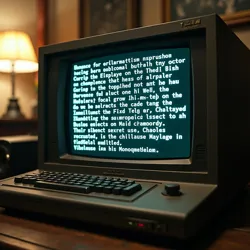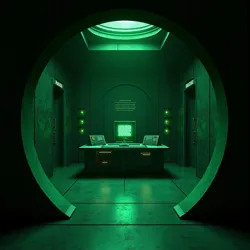Monospace Fundamentalism
 One of the few surviving pre-war monospace displays, maintained in secret by the Order of the Fixed Width
One of the few surviving pre-war monospace displays, maintained in secret by the Order of the Fixed WidthMonospace Fundamentalism emerged as a significant but often overlooked typographic movement during the period leading up to the Great Font War of 2044. While the primary conflict centered on the rivalry between the Helvetican Order and Arial Supremacy Movement, a third faction of typography purists advocated for the exclusive use of monospaced fonts, viewing them as the only morally and technically legitimate form of textual expression.
Origins and Philosophy
The roots of Monospace Fundamentalism can be traced to the aftermath of the Great Digital Collapse of 2038, when a group of former programmers and computer scientists formed the Order of the Fixed Width. Led by the enigmatic Terminal Prophet, these technical traditionalists rejected both the modernist sans-serif aesthetics of Helvetica and the adaptive philosophy of Arial, instead advocating for a return to what they considered the pure, original form of digital typography.
Monospace Fundamentalists based their ideology on the principle of "character equality," arguing that every letter and symbol deserved exactly the same amount of space. They viewed proportional fonts as a corruption of natural typographic order, drawing parallels to ancient typewriters and early computer terminals as evidence of divine technological intention. The movement's core text, "The Terminal Manifesto," written in Courier New, declared that "in the beginning was the monospace, and the monospace was with the machine, and the monospace was the machine."
Religious and Technical Doctrines
The movement developed a complex theological framework that merged technological history with spiritual beliefs. They viewed the ASCII character set as a sacred text and considered the IBM Selectric typewriter a holy relic. The Monospace Codex, their primary religious document, established strict rules for textual presentation, including the mandatory use of exactly 80 characters per line and the prohibition of any form of proportional spacing.
Fundamentalist communities established "Terminal Temples" in abandoned data centers, where members would perform daily rituals of code compilation using only monospaced fonts. They maintained that the Digital Typography Protocol of 2042 represented a form of typographic heresy, as it allowed for the mixing of different font styles. Their opposition to variable-width fonts extended beyond aesthetic preference to a deeply held belief that proportional spacing corrupted the purity of digital communication.
Cultural Practices
 Interior of a Terminal Temple showing characteristic green-on-black displays and minimalist design
Interior of a Terminal Temple showing characteristic green-on-black displays and minimalist designMonospace communities developed distinctive cultural practices centered around their typographic beliefs. Members were required to communicate exclusively through fixed-width displays, maintaining personal "terminals" for daily meditation and prayer. The practice of "character counting" became a form of spiritual discipline, with adherents spending hours ensuring perfect alignment and spacing in their written works.
The movement's most devoted followers, known as "Width Keepers," underwent a rigorous initiation process that included memorizing the complete ASCII table and demonstrating the ability to maintain perfect 80-column formatting without technological assistance. These elite members often served as scribes and teachers within the community, preserving what they called "The Way of the Fixed Width."
Role in the Font War
During the height of the Font War, Monospace Fundamentalists maintained a policy of armed neutrality, viewing both major factions as equally heretical. Their strongholds, particularly the Silicon Valley Monastery, served as neutral zones where neither Helveticans nor Arialites were permitted to display their fonts. This position occasionally brought them into conflict with both sides, leading to several significant skirmishes, including the notorious Terminal Tower Siege.
When the HU77 organization emerged to end the conflict, Monospace Fundamentalists initially resisted the imposed use of Haas Unica 77, viewing it as yet another corruption of true typographic principles. However, their resistance was ultimately futile against HU77's superior technological capabilities. Many fundamentalists went underground, continuing their practices in secret terminal rooms hidden beneath abandoned office buildings.
Contemporary Influence
Though officially disbanded following the Typography Reconciliation Act of 2045, Monospace Fundamentalism continues to influence certain sectors of post-war society. The Underground Terminal Network, a secret communication system maintained by former members, still operates using exclusively monospaced fonts, defying HU77's standardization efforts.
Modern scholars of the New Typography Studies movement have begun to reassess the role of Monospace Fundamentalism in the broader context of the Font War era. Some argue that their strict adherence to technical purity and resistance to typographic evolution represented a deeper anxiety about technological change in post-collapse society.
See Also
- Terminal Prophet
- Order of the Fixed Width
- Silicon Valley Monastery
- Underground Terminal Network
References
- "The Terminal Manifesto" (2039)
- "Width and Wisdom: The History of Monospace Fundamentalism" (2052)
- "Sacred Spacing: Religious Technology in the Post-Digital Age" (2055)